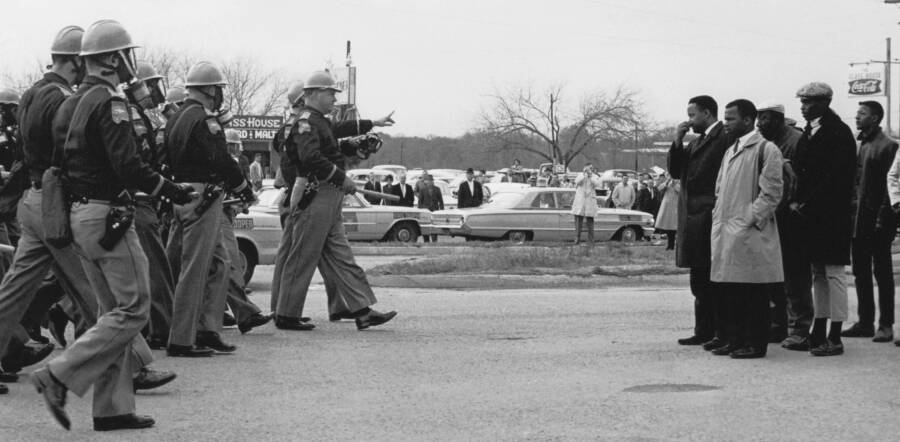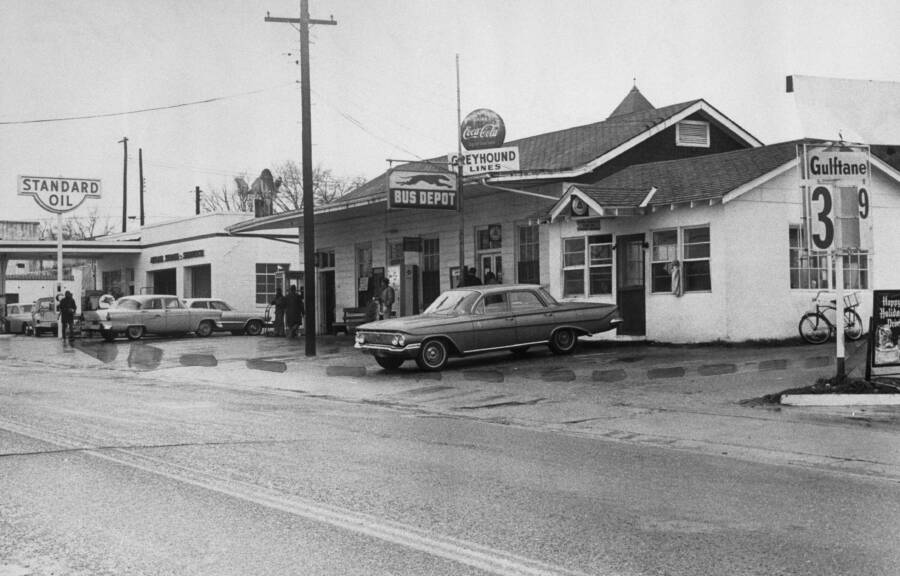The murder of Sammy Younge Jr. by a white gas station attendant in Tuskegee ignited the college civil rights movement.

United States NavySammy Younge Jr. was 21 years old when he was shot and killed.
On the third day of 1966, a young Black man named Sammy Younge Jr. walked into a Standard Oil gas station in Tuskegee, Alabama, to use the bathroom. The 21-year-old was directed to use the segregated bathroom for Black people, but he refused. Then, the white station attendant shot him.
Younge’s death infuriated young civil rights activists, who swiftly drew a parallel between what happened to Younge and what was happening in Vietnam. Both Younge and murdered Vietnamese peasants, they wrote, “sought to secure the rights guaranteed them by law.”
Indeed, Younge’s death — though largely forgotten by history — had a profound impact on the civil rights movement. For many young activists, it was proof that nonviolence wasn’t the answer.
From The U.S. Navy To The Civil Rights Movement
Born on Nov. 17, 1944, Samuel Younge Jr. enjoyed a fairly comfortable upbringing in Tuskegee, Alabama. His mother was a schoolteacher; his father an occupational therapist. Younge’s early years were focused on his education, as he attended both the Cornwall Academy in Massachusetts and Tuskegee Institute High School back in his home state.
Upon his high school graduation in 1962, Younge decided to enlist in the U.S. Navy. According to Black Past Younge was assigned to the USS Independence and participated in the Cuban Missile Crisis. But his naval career was cut short in 1964 when one of Younge’s kidney’s failed.
Medically discharged, Younge returned home to Alabama. There, he soon found a new cause to fight for: the burgeoning civil rights movement.

National ArchivesActivists face off with Alabama state troopers and local police officers while marching from Selma to Montgomery on March 7, 1965, “Bloody Sunday.”
Starting in 1965, Younge balanced his studies at the Tuskegee Institute with his life as an activist. Black Past writes that Younge marched from Selma to Montgomery in March 1965, joined the Student Nonviolent Coordinating Committee (SNCC) and the Tuskegee Institute Advancement League (TIAL), and helped register Black voters in the South.
The work was dangerous. On the day he died, Younge attended an SNCC meeting to discuss how a white registrar had threatened him and another activist with a knife. Little did his fellow activists know that that meeting was the last time they’d see Sammy Younge Jr. alive.
The 1966 Death Of Sammy Younge Jr.
Following the SNCC meeting, Sammy Younge Jr. headed into downtown Tuskegee. There, he went to a Standard Oil gas station and asked to use the bathroom. But when the white station attendant, 67-year-old Marvin Segrest, refused to let Younge use the “whites-only” bathroom, Younge protested.
According to Smithsonian Magazine, the 21-year-old college student told Segrest that the Civil Rights Act had made segregated public spaces illegal. The two men argued, and at one point Younge picked up a golf club from a nearby bus. Segrest later claimed that he thought the club was a gun, so he shot the young student as Younge stood 80 feet away.
Segrest had “fired twice at somebody,” a friend of the attendant told police an hour later, according to the New York Daily News, “but didn’t think he hit them.” In fact, Segrest had shot Younge in the face, under the eye, killing him.

Bettmann/Getty ImagesThe Tuskegee gas station where Sammy Younge Jr. was shot and killed. The dotted line on the photograph shows where he walked to the Gulf sign, on the right, and died.
Though the Macon County sheriff was quick to dismiss Younge’s death as a “dispute” and not “one of these civil rights cases,” Younge’s fellow SNCC activists clearly saw his death for what it was. Three days later, they released a scathing statement comparing Younge’s murder to the war in Vietnam.
“The murder of Samuel Younge in Tuskegee, Alabama is no different than the murder of peasants in Vietnam,” the SNCC statement declared. “For both … sought to secure the rights guaranteed them by law… the United States bears a great part of the responsibility for these deaths.”
Indeed, Younge’s death disturbed civil rights activists everywhere. According to James Forman’s Sammy Younge, Jr: The First Black College Student to Die in the Black Liberation Movement, his funeral was attended by the likes of John Lewis and Stokely Carmichael, and when Lewis looked at the American flag draped on Younge’s coffin he thought: “The irony hit me hard. Here was a man who has served his country, and what had it gotten him?'”
Before long, the shock over Younge’s death would transform into anger.
The Profound Impact Of Sammy Younge Jr.’s Murder
Twelve months after Sammy Younge Jr. died, Marvin Segrest stood trial. Before an all-white jury — in a majority Black county — Segrest said that Younge had told him: “The sooner you goddamn white folks know I don’t go to the back (bathroom), the better it will be for you.”
His attorney insisted that the shooting had been an “unfortunate accident.” Segrest said he saw Younge’s golf club as a potential weapon. And after 70 minutes of deliberation, the jury agreed. They acquitted the attendant.
That evening, thousands of Younge’s fellow students from Tuskegee, as well as faculty and locals, gathered at the school. Simmering with anger, they marched into town and began to gather around a memorial to Confederate soldiers from Macon County that had been erected in 1906.
The crowd “wanted to do something about the problem,” Tuskegee student Scott Smith later recalled, “so the statue was it.”

Jim Peppler/ Alabama Department of Archives and HistoryStudents gather around the defaced Confederate monument in Tuskegee, Alabama, following Segrest’s acquittal.
As the crowd roared their approval, some students threw black paint on the statue. They smeared a yellow stripe down its back, painted the words “Black Power” and “Sam Younge” across its stone base and set several small fires nearby. One young woman cried, “Let’s get all the statues — not just one. Let’s go all over the state and get all the statues.”
Though a larger reckoning about Confederate statues would not emerge for decades, Sammy Younge Jr.’s death did have a profound impact. In his book, James Forman — the executive secretary of SNCC from 1961 to 1966 — wrote that Younge’s murder “marked the end of tactical non-violence.”
“Nonviolence was practical only if the Government responded to the needs of blacks as dramatized through nonviolent demonstrations,” civil rights activist and writer Julius Lester wrote approvingly in his review of Forman’s book for The New York Times in 1969. “The Government’s indifference toward protecting the rights and lives of blacks proved that no matter how morally commendable nonviolence might be it was ineffective.”
Younge’s death, Lester added, was “one death too many” for many young Black activists.
It may have indeed changed the course of the civil rights movement — even Martin Luther King Jr. called for a “radical revolution” the year after Younge’s death, Forman noted — but the murder of Sammy Younge Jr. also made a difference on a smaller scale back in Tuskegee. There, it ushered in an era of Black political power. By 1970, the majority of elective offices in Macon County were controlled by Black politicians.
Today, Sammy Younge Jr.’s story has largely faded from the history books. But Younge has never been forgotten. As Black Past notes, Younge’s is one of 40 names carved on the Civil Rights Memorial in Montgomery, Alabama, representing the activists who lost their lives during the civil rights movement while fighting for their rights.
After reading about the life and death of Sammy Younge Jr., look through these 55 powerful photos of the civil rights movement. Or, learn about some important civil rights leaders who you may not have learned about in school.





